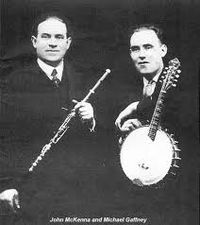Annotation:Over the Moor to Peggy: Difference between revisions
No edit summary |
No edit summary |
||
| Line 1: | Line 1: | ||
---------- | |||
{{TuneAnnotation | |||
|f_tune_annotation_title= https://tunearch.org/wiki/Annotation:Over_the_Moor_to_Peggy > | |||
|f_annotation='''OVER THE MOOR TO PEGGY''' (Trasna an mhóinteáin go Peige). AKA and see "[[Arboe (2)]]," "[[Come West Along the Road]]," "[[Bog Siar an Bóthar]] (Come West Along the Road)," "[[Monasteraden Fancy (The)]]." Irish, Reel. G Major. Standard tuning (fiddle). AB (Breathnach). A different tune than the Northumbrian "[[Over the Moor to Betty]]" and the Irish "[[Over the Moor to Maggie (1)]]/[[Over the Moor to Maggie (2)]]." O'Neill prints a version called "Come West Along the Road," albeit with a different second part. | |||
---- | |||
---- | |||
'''OVER THE MOOR TO PEGGY''' (Trasna an mhóinteáin go Peige). AKA and see "[[Arboe (2)]]," "[[Come West Along the Road]]," "[[Bog Siar an Bóthar]] (Come West Along the Road)," "[[Monasteraden Fancy (The)]]." Irish, Reel. G Major. Standard tuning (fiddle). AB (Breathnach). A different tune than the Northumbrian "[[Over the Moor to Betty]]" and the Irish "[[Over the Moor to Maggie (1)]]/[[Over the Moor to Maggie (2)]]." O'Neill prints a version called "Come West Along the Road," albeit with a different second part. | |||
[[File:mckenna.jpg|200px|thumb|left|John McKenna & Michael Gaffney]] | [[File:mckenna.jpg|200px|thumb|left|John McKenna & Michael Gaffney]] | ||
The tune was played by the great flutist John McKenna (b. 1880, Tents, Tarmon, County Leitrim) who recorded it in New York in 1925, accompanied by banjo player Michael Gaffney (b. 1896, Mullaun, Co. Roscommon). Despite being from different counties, they were in fact neighbors in Ireland, points out Reg Hall (1995), and only lived a mile from each other. Both emigrated to New York (in 1911 and 1915, respectively), where they paired to produce a number of successful recordings and to entertain in the Irish dance halls of the 1920's and 1930's. "Over the Moor to Peggy" is distantly related in the first strain to the family of tunes that includes "[[Ballina Lass]]," "[[Gearrchailiu Chontae Mhuigheo]]," "[[Hag's Reel (The)]]," "[[Johnny When You Die (1)]]," "[[Mayo Lasses (The)]]," "[[Old Maid of Galway (The)]]," "[[Paddy's Gone to France]]," and the Cape Breton variant "[[West Mabou Reel]]." | The tune was played by the great flutist John McKenna (b. 1880, Tents, Tarmon, County Leitrim) who recorded it in New York in 1925, accompanied by banjo player Michael Gaffney (b. 1896, Mullaun, Co. Roscommon). Despite being from different counties, they were in fact neighbors in Ireland, points out Reg Hall (1995), and only lived a mile from each other. Both emigrated to New York (in 1911 and 1915, respectively), where they paired to produce a number of successful recordings and to entertain in the Irish dance halls of the 1920's and 1930's. "Over the Moor to Peggy" is distantly related in the first strain to the family of tunes that includes "[[Ballina Lass]]," "[[Gearrchailiu Chontae Mhuigheo]]," "[[Hag's Reel (The)]]," "[[Johnny When You Die (1)]]," "[[Mayo Lasses (The)]]," "[[Old Maid of Galway (The)]]," "[[Paddy's Gone to France]]," and the Cape Breton variant "[[West Mabou Reel]]." | ||
|f_source_for_notated_version=flute player Tommy Hunt, 1966 (Ballymote, Co. Sligo, Ireland) [Breathnach]. | |||
|f_printed_sources=Breathnach ('''Ceol Rince na hÉireann vol. II'''), 1976; No. 206, p. 107. | |||
|f_recorded_sources=Séamus Begley & Oisín Mac Diarmada - "Le Chéile/Together" (2012). Columbia 33075-F (78 RPM), John McKenna & Michael Gaffney (1925, 2nd tune in set, preceded by "[[Maids of Galway (2) (The)]]). Green Linnett SIF1035, Brian Conway & Tony De Marco - "The Apple in Winter" (1981. A similar setting to the one given in Breathnach, learned from "a rare tape" of New York fiddler Lad O'Beirne). James Kelly - "Capel Street." Shanachie Records, John Carty - "Last Night's Fun" (2005). Topic TSCD602, John McKenna & Michael Gaffney - "Irish Dance Music" (1995. A reissue of the 1925 original). Téada - "Inné Amárach" (2006). | |||
|f_see_also_listing=Alan Ng's Irishtune.info [https://www.irishtune.info/tune/1491/]<br> | |||
Alan Ng's Irishtune.info [https://www.irishtune.info/tune/1491/]<br> | |||
Jane Keefer's Folk Music Index: An Index to Recorded Sources [http://www.ibiblio.org/keefer/o10.htm#Ovethmot1]<br> | Jane Keefer's Folk Music Index: An Index to Recorded Sources [http://www.ibiblio.org/keefer/o10.htm#Ovethmot1]<br> | ||
}} | |||
------------- | |||
---- | |||
Revision as of 03:41, 31 July 2022
X:1 T:Over the Moor to Peggy R:reel Z:id:hn-reel-710 Z:transcribed by henrik.norbeck@mailbox.swipnet.se M:C| L:1/8 K:G d2BG DG~G2|DGBG ABce|d2BG DGBd|cBAB c2Bc:| |: dg~g2 egdB|dg~g2 ABcA|dg~g2 defd|cBAB c2Bc:||
OVER THE MOOR TO PEGGY (Trasna an mhóinteáin go Peige). AKA and see "Arboe (2)," "Come West Along the Road," "Bog Siar an Bóthar (Come West Along the Road)," "Monasteraden Fancy (The)." Irish, Reel. G Major. Standard tuning (fiddle). AB (Breathnach). A different tune than the Northumbrian "Over the Moor to Betty" and the Irish "Over the Moor to Maggie (1)/Over the Moor to Maggie (2)." O'Neill prints a version called "Come West Along the Road," albeit with a different second part.

The tune was played by the great flutist John McKenna (b. 1880, Tents, Tarmon, County Leitrim) who recorded it in New York in 1925, accompanied by banjo player Michael Gaffney (b. 1896, Mullaun, Co. Roscommon). Despite being from different counties, they were in fact neighbors in Ireland, points out Reg Hall (1995), and only lived a mile from each other. Both emigrated to New York (in 1911 and 1915, respectively), where they paired to produce a number of successful recordings and to entertain in the Irish dance halls of the 1920's and 1930's. "Over the Moor to Peggy" is distantly related in the first strain to the family of tunes that includes "Ballina Lass," "Gearrchailiu Chontae Mhuigheo," "Hag's Reel (The)," "Johnny When You Die (1)," "Mayo Lasses (The)," "Old Maid of Galway (The)," "Paddy's Gone to France," and the Cape Breton variant "West Mabou Reel."

